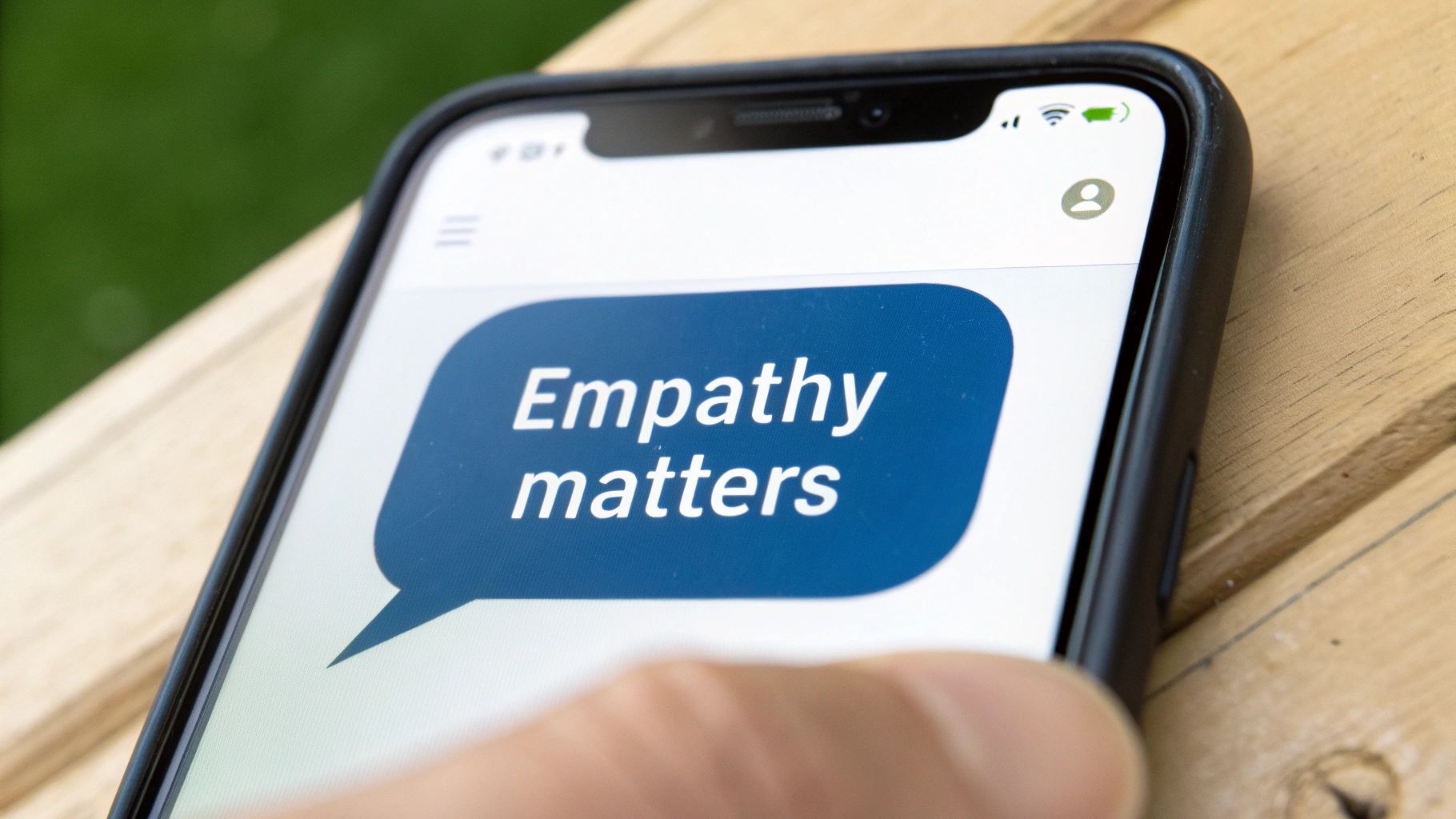When a customer service text lands just right, it’s a perfect mix of speed and a personal touch. It answers the customer's question directly while reassuring them a real person is on the other end, ready to help. At its core, it's about providing instant, convenient support right on their phone—which is exactly where people expect to connect with brands today.
Why Text Is the New Standard for Customer Support
Let's face it: in a world of instant everything, waiting on hold or for an email reply feels painfully outdated. Customers today don't just prefer speed; they demand it. A well-crafted text message can solve a problem in minutes, turning a potential headache into a surprisingly positive brand experience.
This isn't just a fleeting trend. We're seeing a fundamental shift in how people want to interact with businesses. The data doesn't lie: a whopping 81% of customers say a positive service experience makes them more likely to buy again. That's a direct line from the quality of your support to your bottom line, making text-based communication a must-have for any business focused on growth and retention. If you're curious, you can dive deeper into more customer service statistics to see the full picture.
Before we dive into the specific templates, let's quickly break down why SMS support is so powerful.
Here is a quick overview of the strategic advantages of implementing text-based customer service.
Key Benefits of SMS Customer Support
Ultimately, these benefits roll up into a stronger, more resilient customer relationship and a more efficient support operation.
Meeting Modern Expectations
Today's customers expect you to know them. They assume you have their order history and remember their last conversation, regardless of whether it was in your app, through email, or on a previous text thread. This is where a unified SMS platform really shows its value.
- Immediacy: Did you know 76% of customers want to talk to an agent immediately? Texting is the closest you can get to instant, one-on-one support without a phone call.
- Convenience: Texting just fits into life. Customers can send a message from anywhere—the grocery line, a waiting room, their couch—without having to stop everything to dial a number.
- Personalization: Simply using a customer’s name and referencing their recent order in a text shows you see them as a person, not just another ticket number. It's a small detail that makes a huge difference.
The guiding principle is simple: be where your customers are. Offering support via text isn’t just a nice-to-have feature; it’s a strategic move that shows you respect their time and communication preferences.
A smart SMS strategy also paves the way for effective self-service. Think about automated texts for order confirmations, shipping alerts with tracking links, or even quick answers to common questions. This frees up your human agents to tackle the trickier problems that require a real conversation. This blend of smart automation and human expertise is the secret to a customer service operation that truly scales.
Writing Customer Service Texts That Actually Help
 A great customer service text is so much more than a quick reply. It’s a delicate balance of being crystal clear, personal, and professional—all while sounding human. The real goal is to solve problems quickly while making your customer feel good about choosing your brand. It’s the difference between a frustrating dead end and a refreshingly simple solution.
A great customer service text is so much more than a quick reply. It’s a delicate balance of being crystal clear, personal, and professional—all while sounding human. The real goal is to solve problems quickly while making your customer feel good about choosing your brand. It’s the difference between a frustrating dead end and a refreshingly simple solution.
Think about the last update you got. A generic "Your order has shipped" message is fine, but totally forgettable. A truly great message, on the other hand, knows what you need before you do and delivers immediate value.
Make it Personal, Keep it Clear
The best SMS support feels like it was written just for you. Kicking things off by using the customer's name is a small touch that has a huge impact. It shows you see them as a person, not just another ticket number. When customers feel seen, their frustration tends to melt away, making the whole process smoother. Since 86% of customers say they’ll walk away from a company after a bad experience, every single interaction matters.
Of course, that personal touch has to come with absolute clarity. Ditch the corporate jargon and vague promises. If an order is running late, just say so and give them a new, realistic ETA. If they need to track a package, send the direct link—don't make them go on a scavenger hunt through your website.
An effective customer service text doesn't just answer a question; it anticipates the next question. By providing a tracking link or setting clear expectations for a follow-up, you reduce customer effort and build confidence.
Good vs. Bad Texts in the Wild
Let's look at two ways to handle a customer asking about their order status.
- Bad Text: "We have your order. It will ship soon. Please check our website for updates."This is a classic non-answer. It’s impersonal, vague, and actually creates more work for the customer.
- Good Text: "Hi Sarah! Your order #54321 is being packed now and is set to ship tomorrow. You can follow its journey here: [link]. We'll text you again once it's on its way!"See the difference? This message is personal, specific, and gives the customer a direct action they can take for peace of mind.
This simple shift in approach turns a routine text into a proactive and reassuring experience. For a deeper dive, our complete guide to mastering customer service SMS is packed with more templates and best practices. Small tweaks in your phrasing can make a world of difference, turning a standard text into a moment that builds real loyalty.
Essential SMS Templates for Everyday Support

Let's be honest, nobody wants to reinvent the wheel for every single customer question. Having a solid set of SMS templates is your team's secret weapon for delivering support that’s fast, consistent, and genuinely helpful.
This isn't about turning your agents into robots. It's about giving them a reliable starting point. When they have a great foundation, they can stop worrying about the basics and focus on adding the personal touches that solve problems and make customers happy.
Initial Greetings and Confirmations
That first reply is everything. It sets the tone for the entire conversation. It needs to be prompt, clearly acknowledge the customer's reason for reaching out, and give them a realistic idea of when they can expect a solution.
Here are a couple of solid starting points:
- Standard Welcome: "Hi [Customer Name], thanks for reaching out to [Company Name]. My name is [Agent Name], and I'm looking into your question about [Topic] now. I'll have an update for you shortly."
- Appointment Confirmation: "Hi [Customer Name]! Just confirming your appointment with us on [Date] at [Time]. Please reply YES to confirm or call us at [Number] if you need to reschedule. Thanks!"
These simple messages instantly confirm you’ve received their request and that a real person is on the case. That alone can go a long way in calming a frustrated customer.
Key Insight: The best SMS templates use smart placeholders like
[Order Number]or[New ETA]. This small detail makes a standardized message feel personal and ensures your team is sharing specific, useful information—not just generic fluff.
Updates and Issue Resolution
When things go wrong, keeping customers in the loop is non-negotiable. Proactive updates about a shipping delay or a service issue can turn a negative experience into a positive one by showing you're on top of it. This builds serious trust and cuts down on the number of "Where's my stuff?" messages you get.
For more on strategy and making sure you're following the rules, check out our complete guide to SMS marketing best practices.
- Shipping Delay Alert: "Hi [Customer Name], a quick update on your order #[Order Number]. We're seeing a slight shipping delay, and your new estimated delivery date is [New ETA]. We apologize for the inconvenience and will notify you as soon as it ships."
- Proactive Outage Notice: "Heads up, [Company Name] will be performing system maintenance tonight from 2-3 AM EST. Service may be briefly unavailable. We appreciate your patience!"
Navigating the Common Pitfalls of SMS Support

Running a smooth customer service text channel isn't without its hurdles, but with the right game plan, they're more than manageable. When service gets clunky, it doesn't just annoy customers; it burns out your agents, wastes company resources, and can hit your bottom line. Getting SMS support right means knowing what could go wrong and tackling it head-on.
One of the biggest tripwires is losing that personal connection as your business scales. It's a classic growing pain. Research shows that as companies get bigger, delivering timely, personalized help gets a lot harder. While only 5.7% of small companies tend to miss customer expectations, that number skyrockets to a whopping 35.9% for large firms. It's a stark reminder of how easily the human touch gets lost in standardized, large-scale systems. You can dig deeper into how business size impacts customer care on SlickText.com.
The best way to sidestep this? Empower your team to think beyond the script and solve problems with genuine empathy.
Managing Expectations and Frustration
De-escalating a tense situation over text is a unique art form. You don't have tone of voice or facial expressions to rely on, which means messages can get misread in a heartbeat. The secret weapon here is clear, proactive communication. If you need a moment to look something up, just say so.
- Set Clear Timelines: Instead of a vague "one moment," try something like, "I'm looking into this now. It might take me 5-10 minutes to find the right answer, but I'll be right back with an update."
- Acknowledge Their Feelings: A simple, "I can definitely understand how frustrating that must be," goes a long way. It validates their feelings and shows you're on their side.
- Offer a Path Forward: Always outline the next step. It doesn't matter if it's an immediate fix or a handoff to another team member; just keep the customer in the loop.
The goal is to make the customer feel heard and in control, even when you can't provide an instant fix. This builds trust and transforms a potentially negative interaction into a positive one.
Staying Compliant and Secure
Finally, let's talk about the non-negotiable stuff: compliance. Regulations like the Telephone Consumer Protection Act (TCPA) have strict rules about how and when you can text customers. There’s no wiggle room here.
You must always get explicit, documented consent before adding anyone to an SMS list. Just as important, you have to provide a clear and easy way for them to opt out at any time.
By facing these common issues directly, you can build a customer service text program that's not just effective but also sustainable and a true asset to your brand.
Integrating AI to Supercharge Your SMS Strategy
Let's be honest: blending technology with a real human touch is how you build a smarter SMS support system. The costs of getting this wrong are steep, from burning out your best agents to losing customers and revenue. This is where artificial intelligence can become your team's most powerful ally—not a replacement.
The real goal here is to empower your agents by taking the repetitive, soul-crushing tasks off their plates. Imagine an AI-powered chatbot that handles the initial contact, answers all the common questions, and gathers key info before a human ever steps in. This frees up your team to focus on the complex, nuanced conversations where they can truly shine and build lasting customer loyalty.
The economic fallout from poor customer service is staggering. In the United States alone, companies hemorrhage around $75 billion each year because of bad service experiences. Despite this massive number, only about 25% of support centers have actually brought AI into their daily workflows.
Making AI Practical For Your Team
Integrating AI doesn't mean you have to rip and replace your entire system overnight. The key is to start small and be strategic. A great first step is identifying the most common and time-consuming questions your team fields every single day.
- Triage and Routing: Use a bot to ask simple, upfront questions like, "Is this about an existing order or something new?" From there, it can automatically route the text to the right person or department. No more manual sorting.
- FAQ Automation: Program your AI to give instant answers to questions about your business hours, return policy, or shipping costs. These are easy wins that save everyone time.
- Response Generation: To keep your messaging consistent and high-quality across the board, you can use tools like AI text expanders to help agents reply faster without sacrificing quality.
The best AI strategy doesn't replace people; it enhances their capabilities. It handles the predictable so your team can manage the exceptional. That's how you turn good customer service into a great one.
And a crucial reminder: every single message you send, whether it’s from a bot or a human, needs to follow all the rules. For a complete guide on how to keep your business and your customers protected, make sure you check out our guide on staying compliant with SMS marketing.
Measuring the Success of Your SMS Channel
 If you aren't measuring your SMS customer service, you can't improve it. It's that simple. To get a real sense of the impact your text program is having, you need to look beyond surface-level numbers like reply counts. The most powerful data tells you how efficiently you're solving problems and how customers feel about the whole experience.
If you aren't measuring your SMS customer service, you can't improve it. It's that simple. To get a real sense of the impact your text program is having, you need to look beyond surface-level numbers like reply counts. The most powerful data tells you how efficiently you're solving problems and how customers feel about the whole experience.
So where do you start? A fantastic metric to begin with is first-response time (FRT). This is exactly what it sounds like: how fast your team replies to a customer's first text. A quick FRT isn't just about speed; it shows you respect the customer's time and kicks off the conversation on a positive note, which is huge for retention.
Next up, you have to look at your resolution rate. This is the percentage of support chats that actually end with the customer's problem being solved. A high resolution rate is a clear sign that your team knows their stuff and your support processes are running like a well-oiled machine.
The real magic happens when you tie your SMS metrics directly to bigger business goals. For instance, you can track how text interactions affect customer lifetime value or help reduce churn. This proves the concrete ROI of your entire text-based strategy.
Finally, you need a way to check the temperature of customer happiness. That’s where Customer Satisfaction (CSAT) scores are invaluable, and they're easy to collect with a simple follow-up text. Something as quick as, "On a scale of 1-5, how was your support experience today?" gives you direct, honest feedback. This data helps you see exactly where your customer service texting is hitting the mark and where you have room to grow.
Common Questions About Customer Service Texting
When you start digging into customer service texting, a few common questions always seem to pop up. Let's walk through the big ones so you can sidestep any strategic hurdles before they even start.
How Do I Get Customers to Sign Up?
This is a big one. The key is to make it a no-brainer for them. Don't just ask them to opt-in; sell them on the benefit. Frame it as the absolute fastest way to get order updates, answers, and support.
A simple checkbox during checkout or in their account settings works wonders. It's an easy, one-click decision that puts the value front and center.
What About Compliance and Rules?
Compliance can feel intimidating, but it boils down to a few core principles. The golden rule is to always get explicit consent before you send a single message. No exceptions.
You also have to provide a dead-simple way for people to opt out at any time. A quick reply like "STOP" is the industry standard and a must-have.
Should I Use Automation or Live Agents?
It's not about choosing one over the other. The best systems find a smart balance between the two.
The choice between automation and live agents isn't either/or—it's about balance. Use automation for instant replies and common questions, then route complex issues to a live agent. This creates an efficient system that still feels human.
This hybrid approach gives customers instant answers for simple things while making sure a real person is there to handle the tricky stuff.
How Do I Train My Team for Text Support?
Your team's tone and approach are everything. The most effective training involves walking them through real-world examples of both great and not-so-great texts.
Focus on mastering a tone that’s clear, empathetic, and on-brand. Every single customer service text is an opportunity to build a stronger relationship with your customer, so make sure your team is equipped to nail it every time.
Ready to build a text support system that customers love? Textla provides the tools and support you need to get started in minutes. Learn more about our platform.

